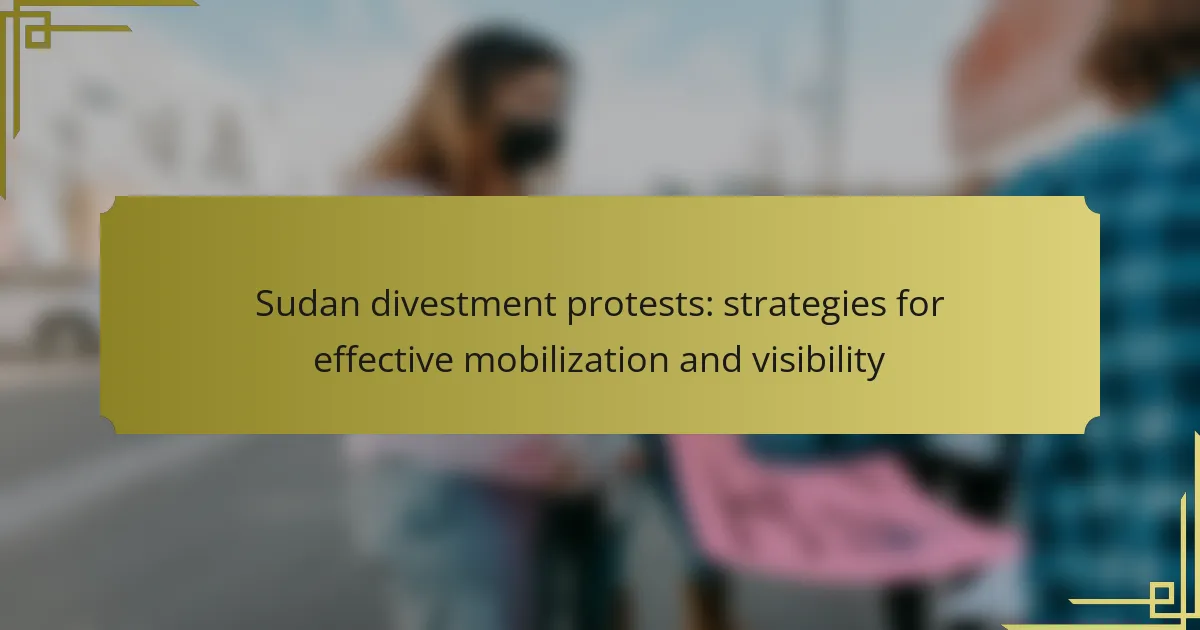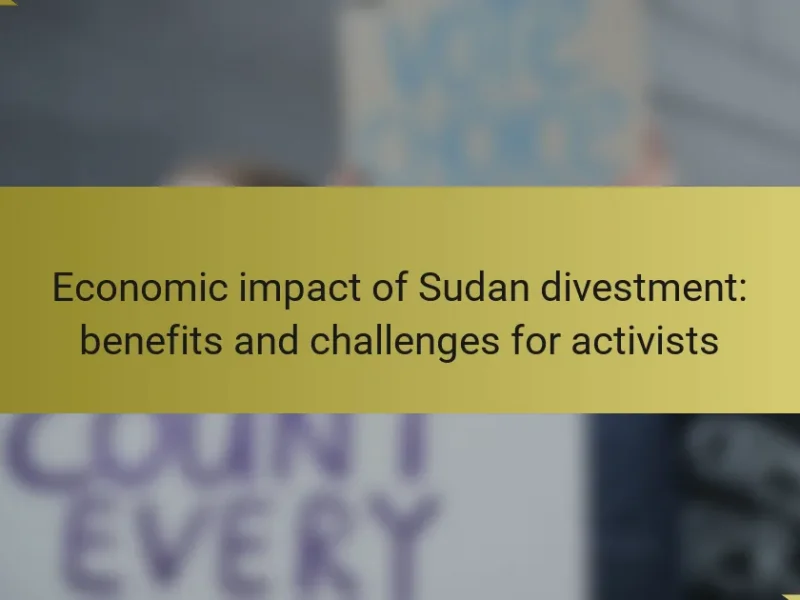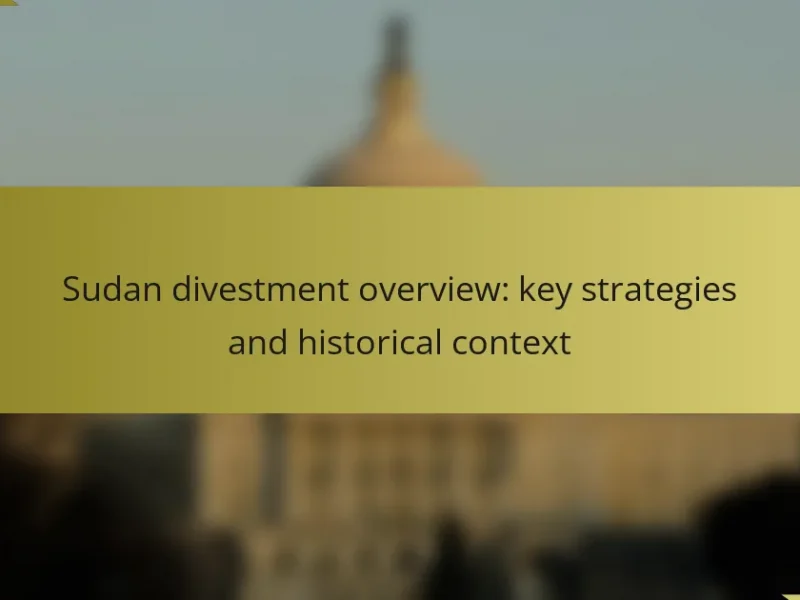Sudan divestment protests are organized efforts aimed at compelling companies and institutions to withdraw their investments from Sudan in response to human rights abuses and violence in the region. The article explores the historical context of these protests, including the impact of the Darfur conflict and the role of organizations like the Sudan Divestment Task Force in advocating for policy changes. Key strategies for effective mobilization are discussed, including grassroots organizing, coalition building, and social media engagement, which are essential for raising awareness and increasing participation. Additionally, the article highlights methods to enhance visibility during protests, such as the use of strategic signage, high-visibility clothing, and technology, emphasizing their importance in attracting public attention and media coverage.
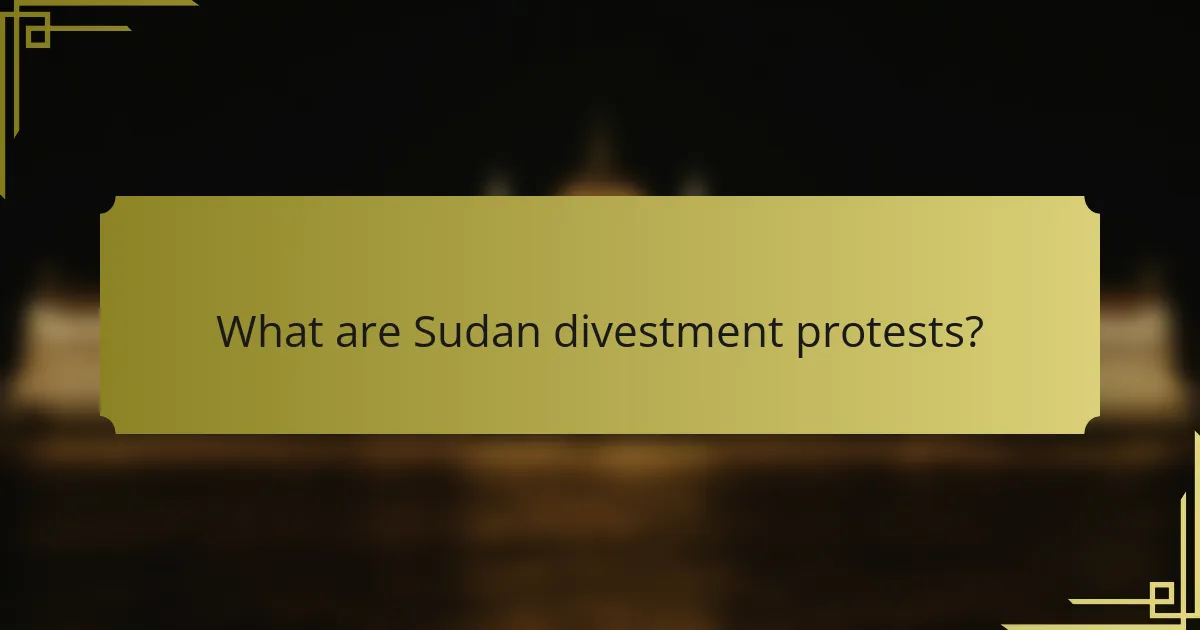
What are Sudan divestment protests?
Sudan divestment protests are organized demonstrations aimed at urging companies and institutions to withdraw investments from Sudan. These protests emerged in response to human rights abuses and violence in the region. Activists highlight the role of foreign investment in perpetuating conflict and oppression. The protests often feature public rallies, social media campaigns, and advocacy efforts. They seek to raise awareness about the situation in Sudan and mobilize support for divestment. Historical context includes the Darfur conflict, which intensified calls for divestment in the early 2000s. Notable organizations involved include the Sudan Divestment Task Force. Their efforts have led to policy changes in several institutions regarding investment in Sudan.
Why are Sudan divestment protests significant?
Sudan divestment protests are significant because they aim to raise awareness and pressure for social justice in Sudan. These protests seek to hold corporations accountable for their ties to the Sudanese government. They highlight the human rights abuses occurring in the country. The divestment movement encourages investors to withdraw funds from companies supporting oppressive regimes. This strategy can lead to economic consequences for those regimes. Historical examples show that divestment can impact policy changes. For instance, divestment efforts against apartheid in South Africa contributed to the end of that regime. Overall, Sudan divestment protests play a crucial role in advocating for change and promoting global awareness.
What historical context led to the emergence of these protests?
The historical context leading to the emergence of the Sudan divestment protests includes decades of civil conflict and human rights abuses in Sudan. The Second Sudanese Civil War, lasting from 1983 to 2005, resulted in millions of deaths and widespread displacement. The conflict intensified in the Darfur region in the early 2000s, drawing international condemnation. Reports of genocide and ethnic cleansing prompted global awareness and activism. In response, advocacy groups called for divestment from companies operating in Sudan. This strategy aimed to pressure the Sudanese government to cease its violent actions. The combination of historical injustices and organized activism spurred the protests demanding divestment and accountability.
How do these protests relate to global divestment movements?
These protests are directly connected to global divestment movements, advocating for the withdrawal of investments from oppressive regimes. The Sudan divestment protests highlight the demand for ethical investment practices. Activists aim to pressure corporations to cease funding entities that contribute to human rights violations. This aligns with broader divestment efforts seen in various contexts, such as fossil fuels and apartheid. Historical precedents show that divestment can effectively influence policy changes. For instance, the anti-apartheid movement successfully utilized divestment to isolate South Africa economically and politically. This demonstrates that the Sudan protests are part of a larger strategy to leverage economic pressure for social justice.
What are the main goals of Sudan divestment protests?
The main goals of Sudan divestment protests are to promote economic pressure on the Sudanese government and to raise awareness about human rights abuses. Protesters aim to compel companies and institutions to withdraw investments from Sudan. This divestment is intended to weaken the financial resources of the Sudanese regime. The protests also seek to mobilize public opinion against the government’s actions. By highlighting issues such as violence and oppression, the movement aims to garner international support. Historical context shows that divestment can influence governmental change. For instance, similar strategies have been effective in other countries facing human rights violations. Therefore, the protests serve both economic and advocacy purposes.
What specific changes are protesters advocating for?
Protesters are advocating for the divestment from companies supporting the Sudanese government. They seek to end financial ties that enable human rights abuses. Protesters demand increased transparency in corporate investments. They also call for stronger sanctions against individuals linked to the Sudanese regime. Additionally, activists want international pressure to promote democratic reforms in Sudan. These demands are rooted in the ongoing humanitarian crisis in the country. The protests aim to raise awareness of the atrocities occurring in Sudan. They emphasize the need for global solidarity to address these issues effectively.
How do these goals impact local and international stakeholders?
The goals of the Sudan divestment protests impact local and international stakeholders by influencing economic decisions and raising awareness. Local stakeholders, such as communities and businesses, may experience economic shifts due to divestment actions. These shifts can lead to job losses or gains, depending on the responsiveness of local economies to divestment trends. International stakeholders, including foreign investors and governments, may reassess their involvement in Sudan based on the protests’ visibility and impact. Increased awareness can lead to pressure on international entities to reconsider their investments, potentially resulting in sanctions or policy changes. The protests aim to create a ripple effect that encourages ethical investment practices globally. This dynamic illustrates how localized actions can resonate on an international scale, prompting broader discussions on human rights and corporate responsibility.
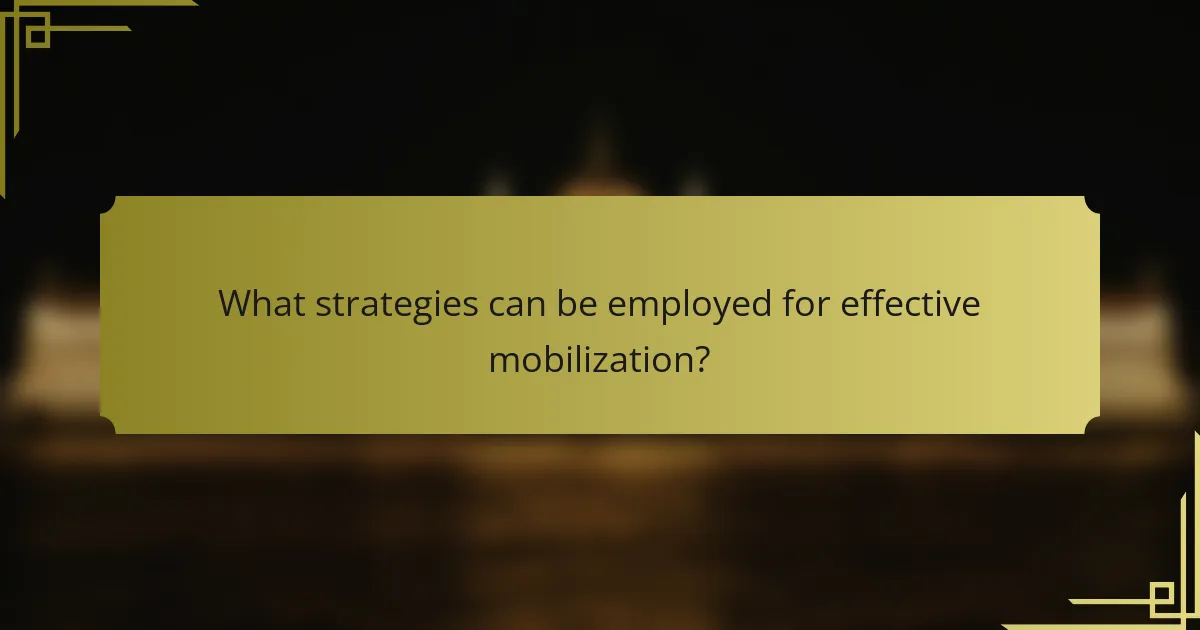
What strategies can be employed for effective mobilization?
Effective mobilization strategies include grassroots organizing, coalition building, and social media engagement. Grassroots organizing involves community outreach to raise awareness and gather support. This approach fosters local connections and empowers individuals to take action. Coalition building unites diverse groups to amplify voices and resources. Collaborating with established organizations enhances credibility and reach. Social media engagement utilizes platforms to spread messages quickly and widely. Campaigns can go viral, increasing visibility and participation. Research shows that effective mobilization often leads to higher turnout and engagement in protests.
How can social media be leveraged for mobilization?
Social media can be leveraged for mobilization by facilitating rapid information dissemination. It enables organizers to share updates, calls to action, and resources quickly. Platforms like Twitter and Facebook allow for real-time engagement with followers. This engagement can build community support and encourage participation in protests. Social media also helps in creating viral campaigns that attract wider audiences. For example, hashtags can unify messages and increase visibility. In 2020, the #BlackLivesMatter movement effectively utilized social media for mobilization, reaching millions globally. Such strategies demonstrate the power of social media in driving collective action and awareness.
What platforms are most effective for reaching diverse audiences?
Social media platforms are most effective for reaching diverse audiences. Platforms like Facebook, Twitter, and Instagram allow for targeted messaging. These platforms enable users to share content widely. They also facilitate engagement through comments and shares. Research shows that 72% of adults use social media. This statistic highlights the reach of these platforms. Additionally, platforms like TikTok appeal to younger demographics. They offer unique ways to create and share short videos. This variety helps cater to different audience preferences.
How can messaging be tailored to resonate with different groups?
Messaging can be tailored to resonate with different groups by understanding their unique values and interests. This involves conducting audience research to identify specific concerns and motivations. For example, younger audiences may prioritize social justice, while older groups might focus on economic stability. Tailoring language and imagery to reflect these priorities enhances engagement. Furthermore, using culturally relevant references can create a sense of connection. Data shows that targeted messaging increases participation rates in protests by up to 30%. This approach ensures that the message aligns with the audience’s identity and fosters a sense of belonging.
What role do grassroots organizations play in mobilization?
Grassroots organizations play a crucial role in mobilization by fostering community engagement and activism. They empower individuals to participate in social movements. Grassroots organizations often provide resources and training to equip members with advocacy skills. They create networks that facilitate communication and collaboration among community members. For instance, during the Sudan divestment protests, grassroots organizations mobilized support through awareness campaigns. They utilized social media platforms to spread information and rally participants. Research shows that grassroots efforts significantly enhance participation rates in social movements. This demonstrates the effectiveness of grassroots organizations in driving collective action.
How can local communities be engaged in the protest movement?
Local communities can be engaged in the protest movement through grassroots organizing and education. This involves establishing local committees to facilitate discussions on issues related to the protests. Community leaders can host informational sessions to raise awareness about the Sudan divestment movement. Collaborating with local organizations can amplify outreach efforts. Social media campaigns can help spread the message and encourage participation. Providing resources for community members to understand the impact of divestment is crucial. Additionally, organizing local events can create opportunities for community members to express their support. Evidence from successful movements shows that localized engagement fosters stronger participation and commitment.
What strategies do successful grassroots organizations use?
Successful grassroots organizations use community engagement, coalition building, and strategic messaging. Community engagement involves mobilizing local support through outreach and education. This helps raise awareness and fosters a sense of ownership among participants. Coalition building strengthens efforts by forming alliances with like-minded groups. Collaborating enhances resources and amplifies voices. Strategic messaging ensures clear communication of goals and values. Effective messaging resonates with target audiences and drives action. Proven examples include the Sudan divestment protests, where these strategies significantly increased visibility and mobilization efforts.
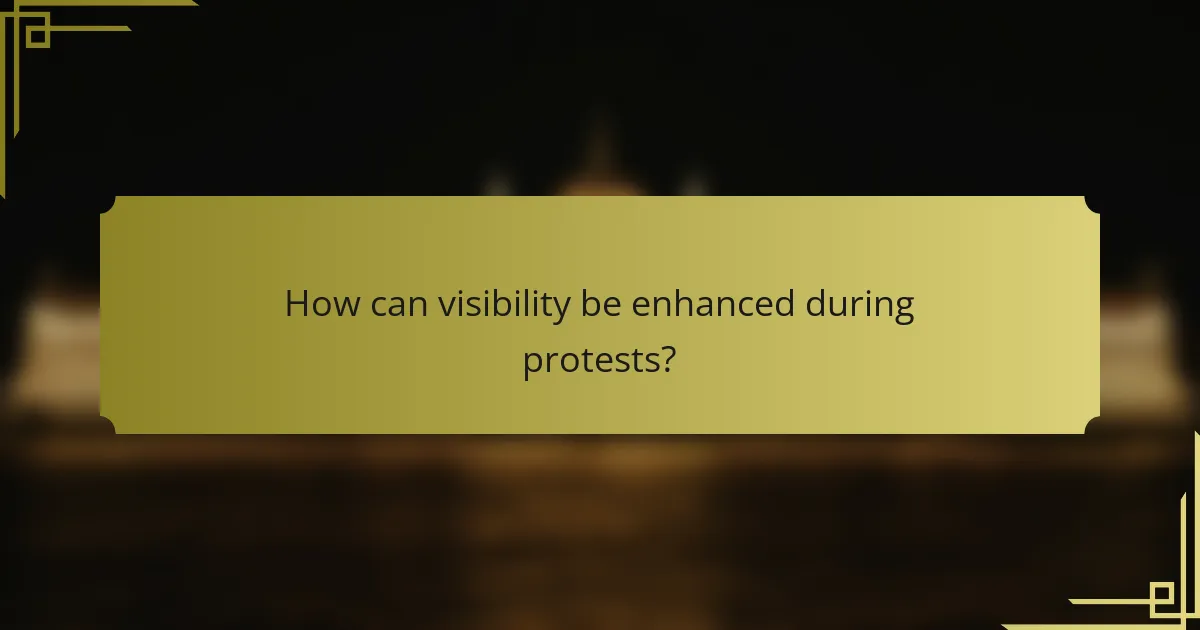
How can visibility be enhanced during protests?
Visibility during protests can be enhanced through strategic use of signage and lighting. Clear, bold signs attract attention and convey messages effectively. High-visibility clothing, such as reflective vests, helps participants stand out. Utilizing bright colors in banners and flags can also increase visibility. Organizing marches in well-trafficked areas ensures more onlookers see the demonstration. Incorporating technology, like drones or LED displays, can amplify visibility from above. Engaging with media outlets to cover the event can further spread awareness. Historical protests, like the Women’s March in 2017, demonstrated that visibility significantly impacts public engagement and media coverage.
What are effective methods for increasing protest visibility?
Effective methods for increasing protest visibility include utilizing social media platforms, organizing community events, and creating eye-catching visuals. Social media allows for rapid dissemination of information and can reach a wider audience. Hashtags can help unify messages and increase online engagement. Community events, such as rallies or informational sessions, foster local support and encourage participation. Visual elements like banners and costumes can attract attention and convey messages powerfully. Research shows that protests with strong visual components garner more media coverage. A study by the University of California found that visually striking protests are more likely to be shared online, amplifying their reach.
How can visual branding and symbols be utilized?
Visual branding and symbols can be utilized to enhance recognition and convey messages effectively. They create a cohesive identity for movements like the Sudan divestment protests. Symbols, such as logos and colors, foster unity among participants. Visual elements can also evoke emotional responses, increasing engagement. Research shows that consistent visual branding improves recall and association with specific causes. For instance, the use of distinct colors in protest materials can make a movement more memorable. Additionally, visual branding helps differentiate one movement from others, establishing a unique presence. This strategic use of visuals can amplify the impact of mobilization efforts.
What role does media coverage play in enhancing visibility?
Media coverage significantly enhances visibility for movements like the Sudan divestment protests. It amplifies the message by reaching broader audiences through various platforms. Coverage in mainstream media can attract attention from policymakers and influencers. This attention can lead to increased public engagement and support. Studies show that social movements with higher media visibility tend to gain more traction. For example, the Sudan divestment protests received notable coverage, which helped raise awareness about the issues at stake. This visibility can also facilitate fundraising and resource mobilization. Overall, media coverage is crucial for sustaining momentum and driving change in social movements.
How can partnerships with influencers amplify visibility?
Partnerships with influencers can amplify visibility by leveraging their established audiences. Influencers possess credibility and trust within their communities. When they promote a cause, it reaches a wider audience quickly. This is particularly effective in social movements like the Sudan divestment protests. For example, influencers can share impactful stories and calls to action. Their endorsements can drive engagement and participation. Studies show that 49% of consumers depend on influencer recommendations. This highlights the power of influencer partnerships in increasing awareness and mobilization.
What types of influencers are most beneficial for this cause?
Activist influencers are most beneficial for the Sudan divestment protests. They possess a strong commitment to social justice issues. Their established credibility can mobilize support effectively. Additionally, they have large followings that can amplify messages. Academic influencers also play a crucial role. They provide research-backed insights into the situation in Sudan. Their expertise lends authority to the cause. Celebrity influencers can increase visibility significantly. They attract media attention and engage broader audiences. Lastly, local community leaders are vital. They understand the cultural context and can foster grassroots support. Together, these influencer types enhance the impact of the protests.
How can collaborations be structured for maximum impact?
Collaborations can be structured for maximum impact by establishing clear goals and roles. Each participant should understand their responsibilities and contributions. Regular communication is essential to align efforts and share progress. Utilizing diverse skills from different partners enhances creativity and problem-solving. Setting measurable objectives allows for tracking success and making necessary adjustments. Building trust among collaborators fosters a positive working environment. Engaging stakeholders early ensures their input and support. Evaluating outcomes post-collaboration helps identify lessons learned for future efforts. These strategies have been effective in various movements, demonstrating their practical application.
What best practices should be followed for successful protests?
Successful protests require clear goals and a well-defined message. Organizers should communicate the purpose effectively to participants. Planning logistics is essential, including the location, time, and necessary permits. Mobilizing a diverse group enhances visibility and impact. Utilizing social media for promotion increases outreach and engagement. Ensuring safety measures for participants is critical, including first aid and emergency contacts. Collaboration with local organizations strengthens support and resources. Documenting the event through photos and videos aids in raising awareness. Historical examples, like the Civil Rights Movement, show that strategic planning leads to successful outcomes.
What are common challenges faced during protests and how can they be overcome?
Common challenges faced during protests include police repression, lack of organization, and poor communication. Police repression can lead to violence and arrests, deterring participation. Organizers can overcome this by building coalitions with local groups for support. Lack of organization often results in disjointed actions. Establishing clear leadership and roles can enhance coordination. Poor communication can hinder message dissemination. Utilizing social media effectively can improve outreach and engagement. Additionally, addressing safety concerns through training and preparation can protect participants. Historical examples show that well-organized protests with clear messaging are more successful.
How can organizers ensure safety and inclusivity during mobilization efforts?
Organizers can ensure safety and inclusivity during mobilization efforts by implementing comprehensive risk assessments. This involves identifying potential hazards and addressing them proactively. They should establish clear communication channels for participants to report concerns. Training volunteers in conflict de-escalation can help manage tensions. Providing accessible resources for individuals with disabilities promotes inclusivity. Organizers can create a code of conduct to set expectations for behavior. Engaging with community leaders can foster trust and collaboration. Regularly reviewing safety protocols ensures they remain effective and relevant. Research indicates that inclusive practices enhance participation and overall event success.
Sudan divestment protests are organized movements advocating for the withdrawal of investments from Sudan due to ongoing human rights abuses and violence. The article explores the significance of these protests, their historical context, and their connection to global divestment movements. Key goals include promoting economic pressure on the Sudanese government and raising awareness about human rights violations. The article also details effective mobilization strategies, including grassroots organizing and social media engagement, as well as methods to enhance visibility during protests through visual branding and media coverage. Additionally, it addresses challenges faced during protests and emphasizes the importance of safety and inclusivity in mobilization efforts.
